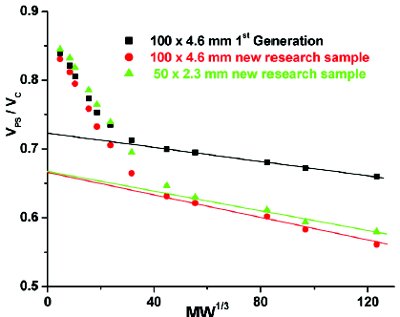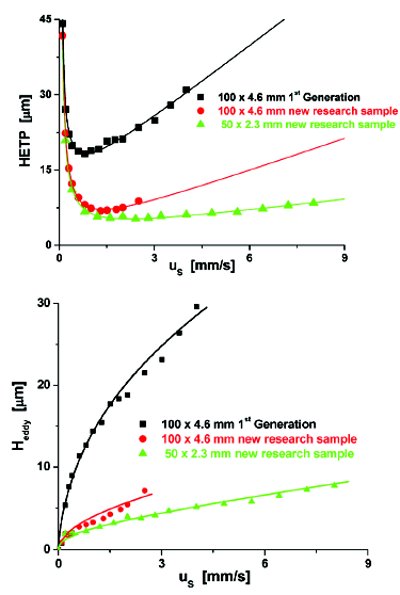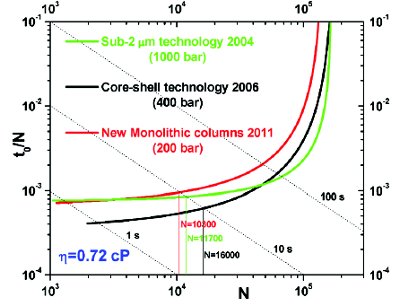Abstract
The progress made in the fabrication of new monolithic columns designed for fast and high resolution liquid chromatography is investigated. The speed (permeability) and mass transfer (van Deemter plot) properties of the first generation of monolithic column is compared to those of two new research samples. Despite a diminution of the permeability (2 x 10-14 m2) by a factor four resulting from the two-fold reduction of the throughpore size, the new prototype monolithic columns exhibit a speed/resolution performance at a pressue drop of 200 bar comparable to that of sub-2 μm particulate columns at 1000 bar. Such high column performance is explained by a significant reduction in the eddy diffusion of the sample caused by the diminution of the domain size and by the structural radial homogeneity of the silica rod. Minimum plate heights as small as 5.2 μm were observed for small retained compounds on a 50 x 2.3 mm monolithic columns.
Introduction
Silica monolithic columns were first prepared and developed in the 1990s [1]. Their structure is based on the continuous interconnection of mesoporous silica skeletons (average diameter 1μm). Remarkably, it was possible to adjust independently the size of the throughpores (2 μm, suitable for convective flow transport) in between the skeletons and that of the mesopores (100-150 Å, necessary for solute adsorption). Eventually, these new materials were promised to a bright future as the revolutionary column technology for fast separations in pharmaceutical, biological, and food industries [2, 3]. They were able to provide the same maximum efficiency as that of 5 μm particulate columns with the advantage at operating at four times less back pressure (constant flow) or at four times faster speed (constant pressure drop) [4].
At the same time, the development of finer particle and very high pressure pumps was still continuing in the 2000s [5] and the particle size went down to 1.7 μm allowing higher column efficiency and faster chromatography with shorter column at 1000 bar [6,7] . Additionally, the rebirth of the old pellicular particles [8,9] in 2006 has produced remarkably efficient columns packed with sub-3 μm core-shell particles at conventional pressures (400 bar) [10] . The 4.6 mm I.D. columns packed with these core-shell particles were found more efficient that those packed with the same particle size but totally porous [11,12]. The large success of this new packing material is essentially due to a diminution of the trans-column eddy diffusion term in the van Deemter equation. It is hypothesized that the large shear friction forces exerted between the rough core-shell particles during the slurry packing process produces radially homogeneous beds [13]. Consequently, the first generation of monolithic silica columns rapidly fell to the oblivion in the end of the last decade. Their main limitation was attributed to a poor eddy diffusion term because of the radial structure heterogeneity of the silica rod [14]. The research and development of new silica monolithic columns consists then today in preparing radially homogeneous structures.
The goal of this work is to measure the kinetic properties (height equivalent to a theoretical plate and specific permeability) of new silica monolithic rods and compare them to those of the first generation of monolithic columns. Based on the use of the experimental kinetic Poppe plot (log(t0/N) vs. log N), the future potential of those new monolithic structures in fast liquid chromatography is discussed.
Theory
Height Equivalent to a Theoretical Plate (HETP) The HETP (H) of the monolithic columns was measured from the first (μ1) and second central (μ’2) moments of the concentration distributions recorded in presence and absence (subscript ex) of the chromatographic column [6]:

where L is the column length. All the moments were measured according to the numerical integration of the recorded peak profiles [15].
Specific Permeability
The specific permeability (ko) of the monolithic column was measured from the slope of the system pressure (P) corrected for the instrument contributions (Pex) recorded by the vHPLC instrument versus a series of flow rates (Fv) in between 0.05 and 0.50 mL/min [4]:

where η is the viscosity of the eluent and Rc is the inner diameter of the column.
Construction of the Isocratic Kinetic Poppe Plots
The Poppe plot plots the decimal logarithm of the hold-up time (t0) per unit of plate number (N) versus the decimal logarithm of the plate number. All the details regarding the construction of isocratic kinetic Poppe plots from the measurements of H and k0 are given in reference [7]. It should be kept in mind that only qualitative conclusions can be drawn from the analysis of the Poppe plots because they assumed that the density and viscosity of the eluent are pressure independent and that the plate height measured at a given velocity is independent of the column length.
The van Deemter Equation
The band spreading of an analyte along a chromatographic column is controlled by three independent mass transfer phenomena, longitudinal diffusion (relaxation of concentration gradients along the column), eddy diffusion (interstitial flow velocity unevenness), and solid/liquid mass transfer resistance. The van Deemter equation is then written [16]:

where B is the longitudinal diffusion coefficient (measured from peak parking experiments [17]), C is the solid/liquid mass transfer resistance coefficient (measured from the combination of the peak parking experiments and a validated model of effective diffusion in a monolithic column [18]), and A is the eddy diffusion HETP term (measured from the subtraction method [18]).
Experimental
All the chromatographic data were acquired with a standard vHPLC instrument equipped with a binary gradient pump, an auto-sampler, a column oven compartment, and a UV diode array detector. The dimensions of the monolithic column of first generation and of the two research monolithic columns were 4.6 mm x 100 mm, 4.6 mm x 100 mm, and 2.3 mm x 50 mm, respectively. A 50 x 3.0 mm column packed with 1.7 μm fully porous particles and a 150 x 4.6 mm column packed with 2.7 μm core-shell particles were also used. The mobile phase and analyte used for the measurement of the columns’ HETPs and permeabilities were a mixture of acetonitrile and water (55/45, v/v) and naphthalene. Neat tetrahydrofuran and a set of eleven polystyrene standards were used for the measurement of the external porosity of the different monolithic silica rods using inverse size exclusion chromatography (ISEC). The temperature was controlled by the lab air-conditioning system at 298 ± 1 K.

Figure 1. Plots of the elution volume, VPS, of a series of eleven polystyrene standards normalized to the column tube volume VC versus the cubic root of the molecular weight of the polymers for the three different monolithic columns as indicated in the legend. The solid line represents the exclusion branches extrapolated to molecular weight of zero. This graph shows that the external porosities of the new research monolithic columns are 10% lower than that of the first generation of monolithic columns (0.66 versus 0.73).
Results and Discussion
In the first three parts of this work, we report and discuss on the measurement of the external porosity, specific permeability, and HETP of the three different columns (1st generation of monolithic column, 4.6 mm I.D. and narrow-bore 2.3 mm I.D. new silica monolithic rods). In the last part, we compare the kinetic Poppe plot of the new monolithic columns with those of reference sub-2 μm fully porous particles and sub-3 μm superficially porous particles.

Figure 2. Plots of the pressure drop along the column versus the superfi cial linear velocity, uS, for the three different monolithic columns as indicated in the legend. Mobile phase: acetonitrile/ water mixture, 55/45, v/v, T=298 K. Note the nearly four times larger pressure drops of the new research monolithic columns with respect to that of the first generation of monolithic columns. This graph indirectly reveals that the throughpore size has been decreased from about 2 μm to 1 μm.
External Porosity
The external porosity of the silica monolith is an important indicator of the skeleton/throughpore size ratio and, to a lesser extent than the throughpore size, aff ects the column permeability. Figure 1 shows the ISEC plots of the three monolithic columns studied in this work. First, all three columns have nearly similar total porosity around 0.83-0.85. Secondly, it is noteworthy that the external porosity estimated from the extrapolation of the exclusion branch to a molecular weight of zero is significantly smaller for the 2nd generation monolithic columns and the narrow-bore 2.3 mm I.D. column (0.66-0.67) than that of the 1st generation monolithic columns (0.72-0.73). This demonstrates that the new monolith research samples have a larger skeleton to throughpore size ratio than the old ones. This could potentially eliminate most of the shrinkage of the silica structure during the aging and drying process and, therefore, lead to more radially homogeneous structures.
Specific Permeability
The specific permeability is the key property of the column when it comes to fast elution chromatography. For the sake of comparison, Figure 2 shows the pressure drop recorded as a function of the linear velocity. Note that the temperature was slightly different at 298.1 K (η=0.77 cP), 296.0 K (η=0.80 cP), and 300.1 K (η=0.73 cP) for the 1st generation of monolithic column, the 2nd generation of monolithic column, and the narrow-bore research sample, respectively. According to Eq. (2), the specific permeabilities of these columns were measured at 7.5x10-14 m2, 1.5x10-14 m2, and 2.0x10-14 m2. These values are consistent with a decrease by a factor two of the average size of the throughpore from 2 μm for the 1st generation of monolithic column to about 1 μm for the new research samples. For that all, the permeabilities of the new research samples are twice larger than that of 2.7 μm core-shell particles [13] (k0=6.0x10-14 m2) and nearly ten times larger than that of sub-2 μm particles [5] (k0 =2.5x10-14 m2). They remain then suitable for fast liquid chromatography.

Figure 3. (Top) Plots of the experimental HETP versus the superficial linear velocity, uS, for the three different monolithic columns as indicated in the legend. Mobile phase: acetonitrile/ water mixture, 55/45, v/v, T=298 K Compound: naphthalene. The solid curves represent the best fit of the HETP data to the van Deemter equation. Note the much lower plate heights measured with the research samples. (Bottom) Same as in the top figure, except the plot of the eddy diffusion term. Note the improvement made in the homogeneity of the structure of the silica rods across its diameter.
HETP and Column Eficiency
The most important property of the monolithic column for achieving high resolution power is a low plate height, H, which measures the dispersion of the sample molecules in length unit along the chromatographic column. Also crucial is how this HETP is increasing over the range of high fl ow rates when short retention times are aimed. Flat HETP curves are definitely suitable for fast chromatography because the loss in resolution will remain minimal while increasing speed. Figure 3A compares the van Deemter curves of the three monolithic columns studied in this work for the retained compound, naphthalene (k~2). Strikingly, the minimum HETP considerably decreases from 18 μm for the 1st generation of monolithic columns (full black symbols) to less than 7 μm for the new research samples (full red and green symbols). A minimum HETP as low as 5.2 microm is even observed for the narrow- bore 50 x 2.3 mm column. This gain in column efficiency results from 1) the diminution of the domain size (sum of the size of the throughpore and skeleton) confirmed from the previous permeability measurements and 2) the significant reduction of the eddy diffusion term, A, in the van Deemter Eq. (3). As a consequence, the minimum HETP shifts towards higher linear velocity from about 0.8 mm/s to 1.3 mm/s and 2.5 mm/s. Additionally, the slope of the HETP curve observed in the high fl ow rate domain decreases. Therefore, the new monolithic samples can definitely allow fast and highly efficient separations.

Figure 4. Comparison between the Poppe plots of three different column technologies as indicated in the legend. Note that, in fast LC or for short analysis time, the new monolith technology is nearly equivalent to sub-2 μm particle technology. Overall, the core-shell technology remains the most successful one.
This diminution of the eddy diffusion term was confirmed from the analysis of the residual eddy diffusion term using the so-called subtraction method [18]. In this method, the longitudinal diffusion term, B/us , and the solid/liquid mass transfer resistance term, Cus, are first measured individually and their sum is then directly subtracted from the overall HETP, H. Figure 3B shows the eddy diffusion terms of the three columns investigated in this work and illustrates the improvement made in the fabrication of new monolithic silica structure with a minimal eddy diffusion term. It can be noted that at a linear velocity of 3 mm/s, the eddy diffusion term measured on the 50 x 2.3 mm column is nearly six times lower than that of the first generation of monolithic column. Therefore, the diminution observed is not exclusively caused by the two-fold diminution of the domain size (throughpore + skeleton size) but is mostly accounted for by the homogeneity of the structure of the new monolithic rods across its diameter.
Speed/Resolution Performance
In order to compare the speed/resolution performance of the new monolithic research samples with those of the reference sub-2 μm particulate columns and columns packed with sub-3 μm core-shell particles, the Poppe plots were constructed for the 50 x 2.3 mm research sample monolith (at 200 bar, the highest inlet pressure tolerated by silica monolithic columns), a 50 x 3.0 mm column packed with 1.7 μm fully porous particles (at 1000 bar, delivered by vHPLC instruments), and a 150 x 4.6 mm column packed with 2.7 μm core-shell particles (at 400 bar, delivered by conventional HPLC instruments). They are shown in Figure 4 where the dotted diagonals represent a fix column hold-up time (or a constant analysis time). Let us assume a hold-up time of only 10 seconds which is typical for fast LC separations today. Despite the much lower operating pressure applied with the monolithic column than that imposed with sub-2 μm particles, the new silica monolithic column can provide nearly as many plates as the very high pressure column (10 300 vs. 11700). It could then be used on standard 400 bar instrument provided the extra-column contribution are minimized with the appropriate injection technique (injection loop directly connected to the injection valve), detection cell volume (< 1 microL) and tubing diameter (80 μm I.D.) [10, 20]. Yet, superficially porous particles can still provide a larger plate count than that of the research monolithic columns, up to 16000 plates at the limit of the operating range of standard instruments.
Conclusions
New research silica monolithic columns designed for fast LC were synthesized by decreasing the throughpore size by a factor two and the external porosity by about 10% with respect to the first generation of monolithic columns. The measurement of their kinetic properties showed that they can provide nearly three times larger efficiency. Better, it is demonstrated that they can potentially be a suitable alternative to the use of columns packed with sub-2 μm particles, which require the use of sophisticated very high pressure liquid chromatographs, in order to achieve fast and high resolution separations.
Acknowledgements
We thank Karin Cabrera (Darmstadt, Germany) and Nobuo Tanaka (Kyoto, Japan) for the generous gift of the research sample monolithic columns
References
- K. Nakanishi and N. Soga, Journal of American Ceramic Society (1991), 74, 2518-2530.
- N. Tanaka, H. Kobayashi, N. N. Ishizuka, H. Minakuchi, K. Nakanishi, K. Hosoya, and T. Ikegami, Journal of Chromatography A (2002), 965, 35-49.
- K. Cabrera, G. Wieland, D. Lubda, K. Nakanishi, N. Soga, H. Minakuchi, and K. K. Unger, Trends in Analytical Chemistry (1998), 17, 50-53.
- M. Kele and G. Guiochon, Journal of Chromatography A (2002), 960, 19-49.
- J. Mazzeo, U. Neue, M. Kele, and R. Plumb, Analytical Chemistry (2005), 77, 460A-647A.
- F. Gritti and G. Guiochon, Journal of Chromatography A, doi:10.1016/j.chroma.(2012), 1228, 2-19.
- F. Gritti, Journal of Pharmaceutical American Review, (2011), April, 1-5.
- Cs. Horvath and S. Lipsky, Journal of Chromatographic Science (1969), 7, 109-116.
- Cs. Horvath and S. Lipsky, Analytical Chemistry (1969), 41, 1227-1234.
- F. Gritti, C. Sanchez, T. Farkas, and G. Guiochon, Journal of Chromatography A (2010), 1217, 3000-3012.
- G. Guiochon, Journal of Chromatography A (2007), 1168, 101-168.
- F. Gritti, A. Cavazzini, N. Marchetti, and G. Guiochon, Journal of Chromatography A (2007), 1157, 289-303.
- G. Guiochon and F. Gritti, Journal of Chromatography A (2011), 1218, 1915-1938.
- J. Abia, K. Mriziq, and G. Guiochon, Journal of Chromatography A (2009), 1216, 3185-3191.
- F. Gritti, and G. Guiochon, Journal of Chromatography A (2010), 1218, 4452-4461.
- J. J. van Deemter, and F.J. Zuiderweg, and A. Klinkenberg, Chemical Engineering Science (1956), 5, 271-289.
- F. Gritti, and G. Guiochon, Journal of Chromatography A (2010), 1217, 5137-5151.
- F. Gritti and G. Guiochon, Journal of Chromatography A, doi:10.1016/j.chroma.(2012), 1221, 2-40.
- H. Poppe, Journal of Chromatography A (1997), 778, 3-21.
- F. Gritti, and G. Guiochon, Journal of Chromatography A (2011), 1218, 4632-4648.
Author Biography
Fabrice Gritti is a Research Scientist in the Department of Chemistry at the University of Tennessee. He received a B.S. degree in Chemistry and Physics from the University Joseph Fourier of Grenoble (France) in 1995, a graduate Engineering school degree in Chemistry and Physics from the University of Bordeaux I (France) in 1997, and a Ph.D. in Chemistry and Physics from the University of Bordeaux I (France) in 2001. Dr. Gritti’s research interests involve liquid/solid adsorption thermodynamics and mass transfer in heterogeneous media for characterization and design of new HPLC column technology.